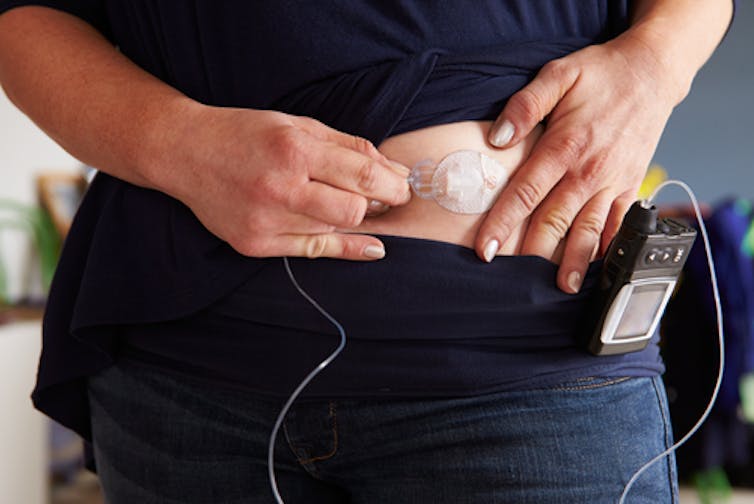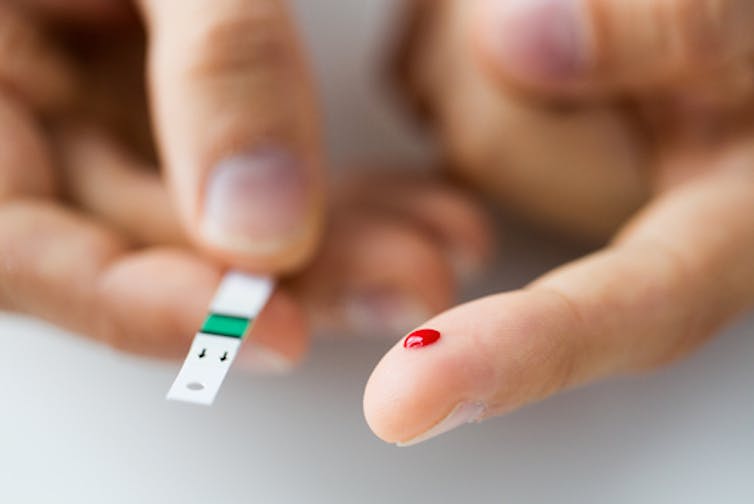How a self-powered glucose-monitoring device could help people with diabetes
- Written by Gymama Slaughter, Executive Director, Frank Reidy Research Center for Bioelectrics, Old Dominion University
Diabetes is the seventh-leading cause of death in the U.S., with about 30.3 million adults[1] having the disease. One in 4 adults[2] does not even know he or she has diabetes.
In addition, 84.1 million adults[3] have prediabetes – a condition with elevated blood sugar levels – and 90 percent of them do not know they have it. The toll therefore is only likely to worsen.
To avoid the life-threatening complications that arise from diabetes, it is extremely important for those with diabetes to keep their blood glucose levels[4] within a safe range. That has long been a difficult challenge, however, because it has been hard to reliably monitor glucose levels.
I am a chemist, chemical and computer engineer who has developed and conducted research on a possible monitoring system that is self-powered. These glucose biosensors[5] convert the biochemical energy stored in blood glucose – in other words, from a person’s own body – to electrical power to run the device.
All about sugar metabolism
Diabetes[6] affects how the body breaks down the food we eat into sugar. This sugar, or glucose, is released into our bloodstream. In response, the pancreas produces a hormone called insulin that enables the body’s cells to take sugar from the blood to use as energy.
If you have diabetes, your body either doesn’t make enough insulin, as in Type 1 diabetes, or it can’t use the insulin it makes as well as it should to maintain healthy blood sugar metabolism. The latter is called Type 2 diabetes. When there isn’t enough insulin, or cells stop responding to insulin, too much sugar stays in your bloodstream. This can lead to serious complications.
Keeping sugar in the blood at a safe level[7] is a key strategy for managing diabetes and preventing progression of the disease. Studies have shown that people on intensive control programs who maintained their blood glucose levels close to normal have fewer complications [8] than people who routinely maintained higher blood sugar levels. About 63.6 percent of adults[9] perform daily self-monitoring of blood glucose.
Maintaining blood glucose levels is a lot harder than it sounds, however. It requires that people pay a lot of attention to the amount of carbohydrates they consume and that they test blood sugar by finger pricks[10] throughout the day. Many must also calculate insulin doses and inject themselves with insulin.
Achieving the glucose control target is very difficult because of fluctuations from diet. Most people are unable to maintain tight control of their blood glucose[11].
And, the disease can progress even if a person is following doctor recommendations to maintain more normal blood glucose. In an effort to keep the levels of blood sugar low, some with diabetes unwittingly place themselves at increased risk for extremely low levels of blood glucose, or hypoglycemia, a life-threatening condition. This fluctuation from high to low levels becomes a barrier for people with diabetes, as they become discouraged. Studies have suggested that some people choose to stop maintaining[12] tight blood glucose control as a result. This further results in inadequate blood glucose monitoring[13] and unhealthy choices.
This situation is worsened because blood sampling is relatively infrequent[14] throughout the day – as few as four times – compared to the countless changes in blood glucose that occur throughout the day. Also, glucose levels[15] depend upon the medication program as well as individual circumstances. Blood sampling provides only a discrete blood glucose record, when a continuous blood glucose record provides the best information.
Devices can help, but they are not perfect
 Glucose monitoring systems help many people with diabetes, but they are not yet widely used.
Monkey Business Images/Shutterstock.com[16]
Glucose monitoring systems help many people with diabetes, but they are not yet widely used.
Monkey Business Images/Shutterstock.com[16]
Studies have shown[17] that the use of devices that can continuously monitor glucose levels could be an answer. These continuous glucose monitoring systems take repeated measurements, typically every five minutes, of blood sugar and the biological fluid that surrounds cells. This enables close monitoring and timely correction of problematic blood glucose levels. Therefore, these systems can reduce the risk[18] of diabetes-related complications.
Those with diabetes can wear one of these monitors in several areas of their body, such as around the stomach, and the back of the arms and legs. But, so far, only a relatively small number of people[19] are wearing them because these devices are not perfect. People still need to test for glucose levels four times a day using a finger prick test. In addition, the devices’ response time is slow, and they are often inaccurate. And, people typically must wear the monitoring device and reinsert it under the skin every seven days. In addition, in randomized trials, continuous monitoring has not been connected with improved quality of life[20].
Also, a recent clinical trial found that the continuous monitors were not able to detect hypoglycemia in order to decrease incidence of the few severe hypoglycemia events that occurred in patients with Type 1 diabetes[21].
A future free of finger pricks?
 Many people with diabetes must prick their fingers several times a day to check their blood sugar levels.
Syda Productions/Shutterstock.com[22]
Many people with diabetes must prick their fingers several times a day to check their blood sugar levels.
Syda Productions/Shutterstock.com[22]
One of the solutions could be fully self-powered implantable devices with no skin-attached components that are less obtrusive and that ease user burden. These self-powered continuous glucose monitoring systems are the next generation of glucose monitors that may reduce the hurdles to continuous glucose monitor use and adherence. They track blood sugar levels and deliver insulin if a person needs it.
In our laboratory, we are developing a self-powered, implantable 4-millimeter by 4-millimeter device. It generates electrical power by converting the chemical energy stored in a person’s blood sugar and works similarly to a battery. It uses proteins attached to two wires that selectively consume glucose and oxygen in our blood to generate electrons that flows through the system. The flow of electrons results in current generation. The product of the current generated and the voltage difference between the two wires results in the production of electrical power. This electrical power is directly proportional to blood sugar concentration. And hence, it can be used to rapidly sense blood sugar with the added benefit of responding to abnormality in blood sugar levels.
The important thing about our platform is it does not require batteries. The electrical power generated can be used to power an implantable insulin pump, thereby allowing us to simultaneously generate power to monitor glucose and deliver insulin to target sites in the body to improve patient health outcomes.
The question is whether this idea of the “closed loop artificial pancreas” can be transformed into reality. The most important challenge is the engineering design required for the artificial pancreas to move the device from bench to clinic and into the body, whereby patients would benefit from a fully automated artificial pancreas that requires no user intervention.
I’m optimistic that there may come a day when such a device can fully automate blood glucose control, provide continuous glucose monitoring and therapeutic delivery without any intervention from the patient. This will improve diabetes management and enable the creation of a world where human power could sustain human life.
References
- ^ 30.3 million adults (www.cdc.gov)
- ^ One in 4 adults (www.cdc.gov)
- ^ 84.1 million adults (www.cdc.gov)
- ^ keep their blood glucose levels (www.diabetes.org)
- ^ These glucose biosensors (www.nature.com)
- ^ Diabetes (www.diabetes.org)
- ^ sugar in the blood at a safe level (www.diabetesforecast.org)
- ^ fewer complications (www.ncbi.nlm.nih.gov)
- ^ 63.6 percent of adults (www.cdc.gov)
- ^ test blood sugar by finger pricks (www.diabetesforecast.org)
- ^ control of their blood glucose (www.diabetes.org)
- ^ some people choose to stop maintaining (link.springer.com)
- ^ inadequate blood glucose monitoring (www.diabetes.org)
- ^ relatively infrequent (www.diabetes.org)
- ^ glucose levels (www.diabetes.org)
- ^ Monkey Business Images/Shutterstock.com (www.shutterstock.com)
- ^ Studies have shown (www.diabetesresearchclinicalpractice.com)
- ^ can reduce the risk (www.diabetes.org)
- ^ small number of people (doi.org)
- ^ improved quality of life (www.ncbi.nlm.nih.gov)
- ^ Type 1 diabetes (www.ncbi.nlm.nih.gov)
- ^ Syda Productions/Shutterstock.com (www.shutterstock.com)
Authors: Gymama Slaughter, Executive Director, Frank Reidy Research Center for Bioelectrics, Old Dominion University

